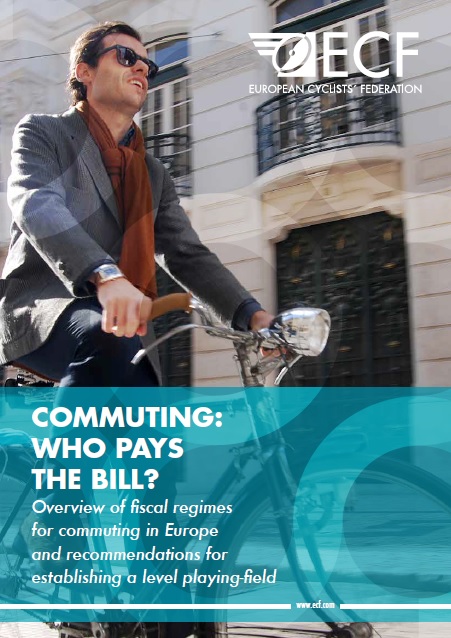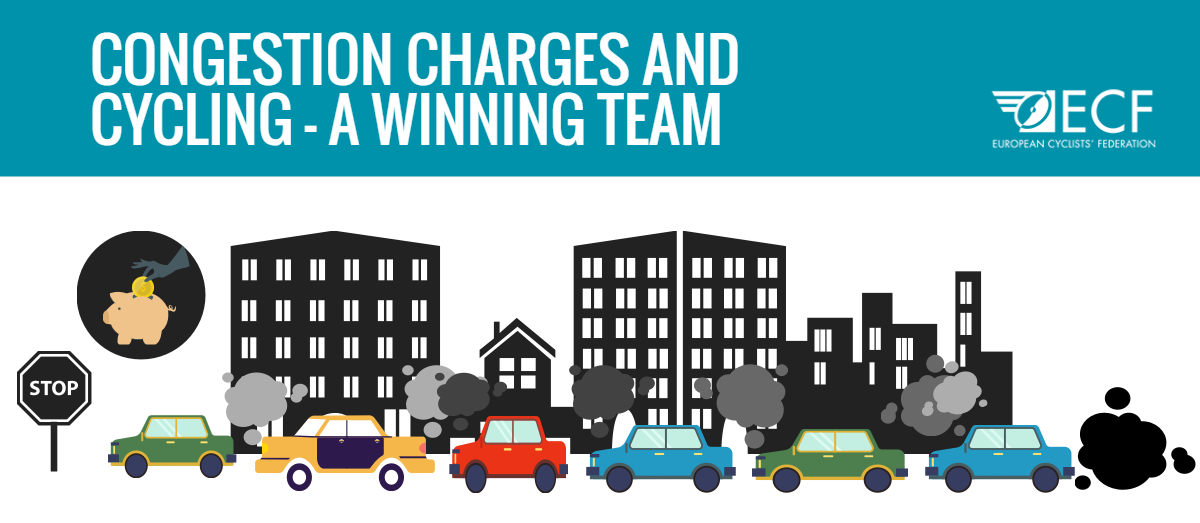Fiscal incentives for commuting
Transport represents almost a quarter of Europe's greenhouse gas emissions and is the main cause of air pollution in cities. The EU has committed itself to reducing transport sector greenhouse gas emissions by 60% in 2050, compared to 1990 levels – but it will not achieve this aim with current fiscal policies for transport in place. To give an overview of national policies, ECF has developed an interactive tool comparing tax regimes for different modes of transport. You can find the tool here.
 The tool is based on an earlier report on fiscal regimes for commuting, providing case studies of 11 European countries, analysing the state of play for fiscality in commuting, and coming up with specific country-by-country recommendations on how fiscal regimes can be used by governments to create a better balanced mobility.
The tool is based on an earlier report on fiscal regimes for commuting, providing case studies of 11 European countries, analysing the state of play for fiscality in commuting, and coming up with specific country-by-country recommendations on how fiscal regimes can be used by governments to create a better balanced mobility.
[Link to ECF report: Commuting: Who Pays The Bill]
While some studies have compared different company car tax regimes in Europe, so far no comparison has been made on how tax systems treat other modes of transport for commuting, such as cycling or public transport. Using input from its Member Organisations and its National Cycling Officer network, ECF has therefore conducted a study comparing different fiscal regimes for commuting by cycling, public transport and car in 11 European countries chosen according to the availability of data. This was done with a view to identify best practices for incentivising sustainable ways of commuting, like the cycling mileage allowance for home-work travel that exists in Belgium or tax exemptions for the provision of bikes by companies to their employees that exist in the UK or in Germany.
This study gives general as well as country-specific policy advice to decision-makers at the European and the national level on how to create a level playing field for all modes of transport throughout Europe, including those – like cycling – which have a positive impact on the environment and public health. In order for this levelling to be achieved, incentives for active and environmentally friendly modes of transport like cycling should be introduced – or extended where they already exist. It should be possible to combine these incentives with those for the use of public transport in order to support intermodality. At the same time, environmentally harmful tax subsidies for e.g. company cars need to be replaced by mode-neutral solutions like mobility budgets in all EU Member States.
Congestion charges

With over 100 billion EUR, congestion costs European cities over 1% of the EU GDP per year. Looking for a solution, ECF studied the implementation of congestion charges in 4 cities over many years: Milan, London, Gothenburg and Stockholm. The new ECF report “Congestion charges and cycling” proves the success of investing revenues from congestion charges into a sustainable mobility plan, and particularly cycling.
 With different approaches, the 4 cities achieved similar, positive results: introducing a congestion charge scheme created net revenues, reduced congestion, improved air quality and was beneficial for sustainable mobility.
With different approaches, the 4 cities achieved similar, positive results: introducing a congestion charge scheme created net revenues, reduced congestion, improved air quality and was beneficial for sustainable mobility.
The study highlights that it is vital to plan the use of the revenues to improve sustainable mobility right from the beginning. To reduce car traffic ECF recommends the investment of net revenues in sustainable modes of transport. This will make the whole process more effective in the long term.
Cycling should play an integral role in this process. In Milan, congestion charges were spent entirely on measures to promote sustainable mobility. At least 3 million EUR were invested in the city’s bike sharing system “BikeMi”, which led to a considerable usage growth concentrated in the area covered by the congestion charge scheme.
In London, research showed that cycling in the inner city increased by an impressive 66% since the introduction of the congestion charge. Cycling has also become safer: crashes in Central London decreased by 40%.
In its "Communication on the Urban Mobility Package" of 2013 (COM(2013) 913), the European Commission identifies smarter urban access regulations and road user charging as a priority area for action. This is confirmed by the accompanying staff working document“A call for smarter urban vehicle access regulations” (SWD(2013) 526). Both documents call for a common approach across the EU and the establishment of non-binding guidance to help cities implement access regulation schemes, including urban road user charging, effectively.
The experiences from London and Milan show that investing net revenues from congestion charging schemes in cycling measures yields impressive results. These examples should be taken into account by other cities considering to introduce similar schemes, but also by the EU when developing non-binding guidance on urban access restrictions. Congestion charges and cycling are a winning team: investing in cycling helps to create an attractive alternative to motorised transport.
Financial incentives for e-cycling
 In addition to the known benefits of cycling, e-bikes have an even greater potential to offer, but up until now they were excluded from most of the electromobility strategies on both European and national levels. For this reason, the European Cyclists’ Federation (ECF) has published a report called Electromobility for all: fiscal Incentives for e-cycling. ‘Despite their obvious advantages and cost-effectiveness, e-bikes are still kept out from e-mobility policies. Therefore, we seek to draw the attention of decision-makers at all levels to the potential they offer. We provide key policy recommendations and best practice examples, with the goal of promoting e-cycling throughout Europe’ – commented Holger Haubold, author of the report and ECF Fiscal and Economic Policy Officer.
In addition to the known benefits of cycling, e-bikes have an even greater potential to offer, but up until now they were excluded from most of the electromobility strategies on both European and national levels. For this reason, the European Cyclists’ Federation (ECF) has published a report called Electromobility for all: fiscal Incentives for e-cycling. ‘Despite their obvious advantages and cost-effectiveness, e-bikes are still kept out from e-mobility policies. Therefore, we seek to draw the attention of decision-makers at all levels to the potential they offer. We provide key policy recommendations and best practice examples, with the goal of promoting e-cycling throughout Europe’ – commented Holger Haubold, author of the report and ECF Fiscal and Economic Policy Officer.
Adding to the economic, environmental, health and other benefits that cycling has to offer, e-bikes are the perfect solution for longer distance trips. In studies, they proved to be faster than cars in trips up to 10 km (twice longer than the ones with conventional bikes). Moreover, they make it easier to overcome natural obstacles (like hills or headwinds), thus they are suitable for commuters wanting to arrive at work in their professional attire, less physically trained cyclists, elderly people and other groups that did not cycle before. Besides, e-bikes make it possible to transport heavier goods, thus providing a great solution for individual shoppers and companies relying on fast urban logistics. Therefore, e-bikes are seen as a potential alternative to cars, especially for trips in urban areas.
In order to keep up with EU CO2 emission commitments, and to reap even more benefits of cycling, decision makers at all levels are encouraged to include e-cycling in their electromobility strategies, and to provide relevant funding mechanisms. The ECF report shows that despite tremendous support for electric cars (1.4 billion euros spent in Germany until 2014!), the payback is rather low (only 25 500 electric cars are rolling on German streets), meanwhile with little investment it is possible to reach a massive surge of electric bikes!
You can find a more detailed overview of incentive schemes in some of EU Member states, benefits of e-bikes and fiscal policy recommendations in the ECF report published online.
